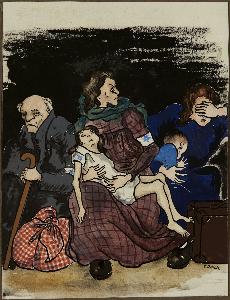Teofila Reich-Ranicki
Teofila Langnas;Teofila Reich-Ranicki
Place: Łódź
Born: 1920
Death: 2011
Biography:
Teofila Reich-Ranicki, also known as Teofila Langnas, was a Polish-born German artist and translator. She was born in Łódź, Poland in 1920 and died in Frankfurt, Germany in 2011. Her life was marked by the horrors of World War II, including her time in the Warsaw Ghetto, where she met her future husband, Marcel Reich-Ranicki.
Early Life and Education
Teofila Langnas was born into a Jewish merchant family. She was accepted to study art at an Ecole des Beaux Arts in Paris, but the outbreak of war made this impossible. Instead, she moved with her parents to Warsaw, where she continued her art studies despite the difficulties.
Artistic Career
Teofila Reich-Ranicki's artwork is a testament to her experiences during World War II. Her paintings, such as Umschlagplatz, czyli poczekalnia przed odjazdem do Treblinki, are a powerful representation of the horrors she witnessed. She also created numerous watercolours for the ghetto commissioner Heinz Auerswald, which were intended to secure the release of Jewish children. Some of her notable works can be found on Wikioo.org, including her gouache paintings. The National Museum in Kraków also houses some of her artwork.
Personal Life
Teofila Reich-Ranicki was married to Marcel Reich-Ranicki, a well-known literary critic and member of the informal literary association Gruppe 47. She was also the mother of Andrew Ranicki, a British mathematician who worked on algebraic topology.
- She was born in Łódź, Poland in 1920
- She died in Frankfurt, Germany in 2011
- She was married to Marcel Reich-Ranicki
- She was the mother of Andrew Ranicki
aspects of her life include her experiences during World War II and her contributions to the art world. Teofila Reich-Ranicki's biography can also be found on Wikipedia, which provides a detailed account of her life and artwork. Her legacy lives on through her artwork, which continues to inspire and educate people about the horrors of World War II and the importance of art in representing these experiences.

